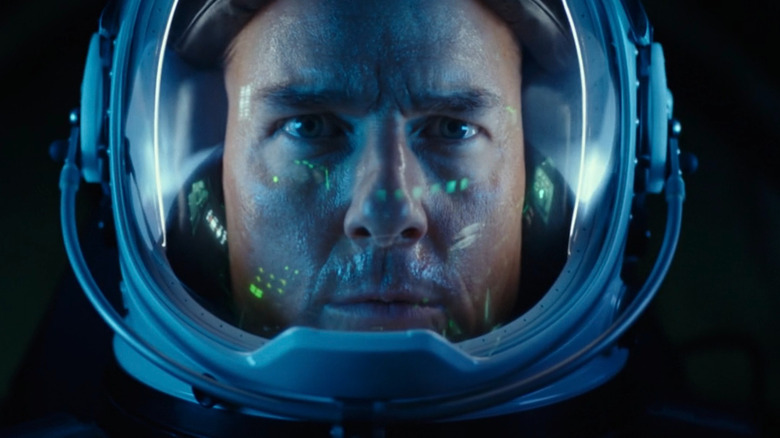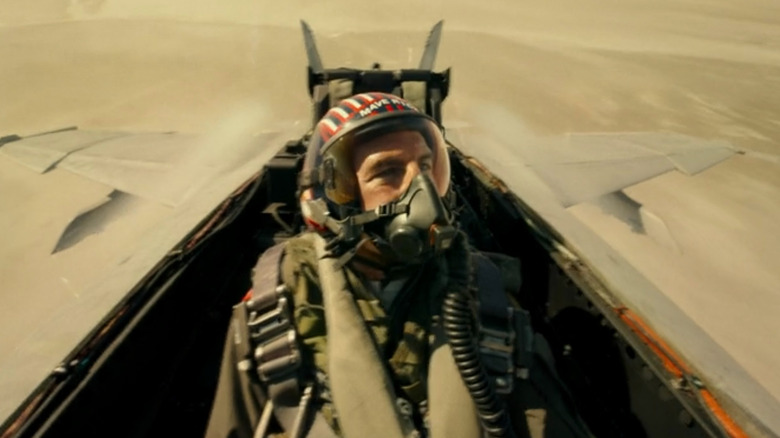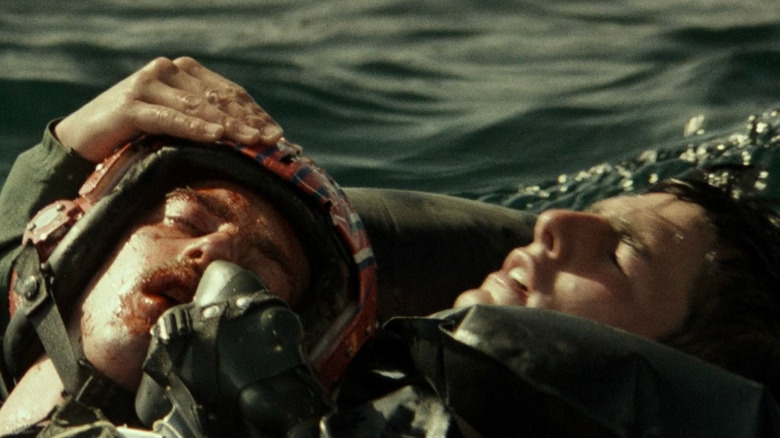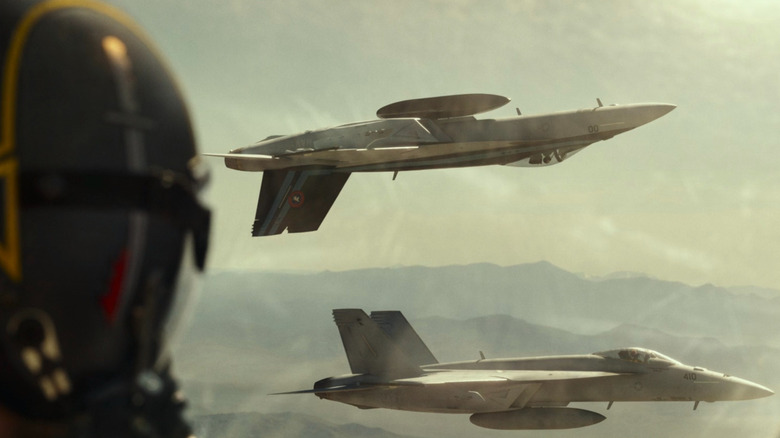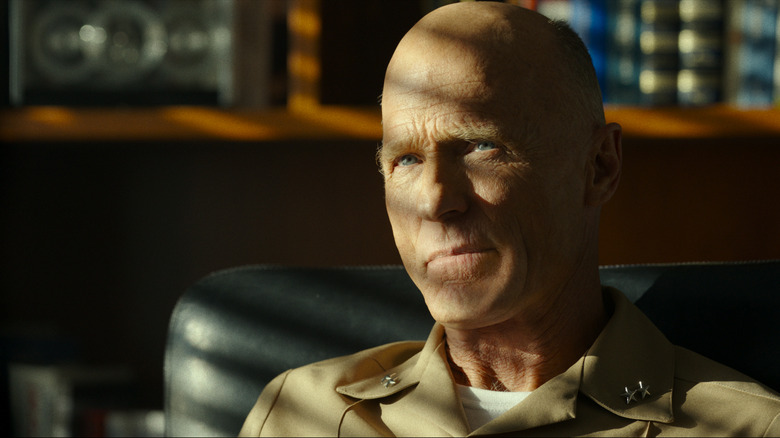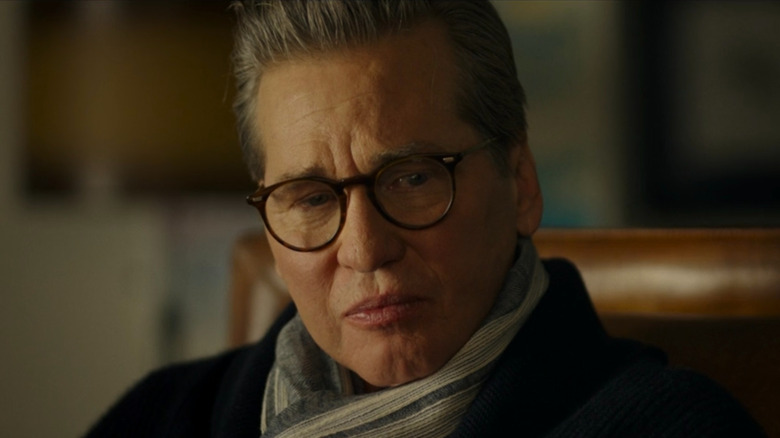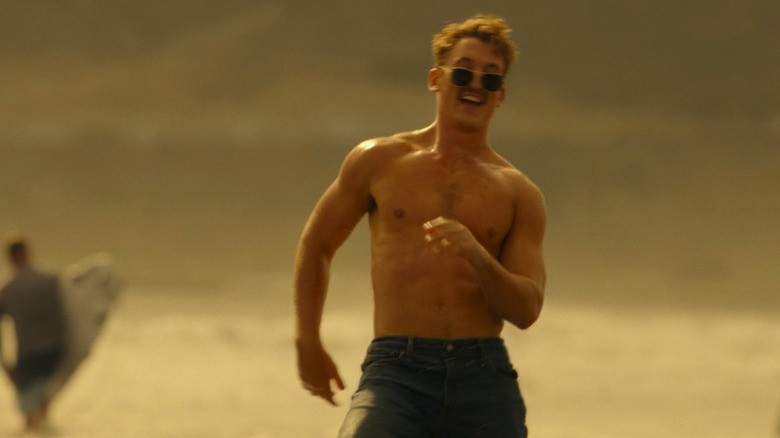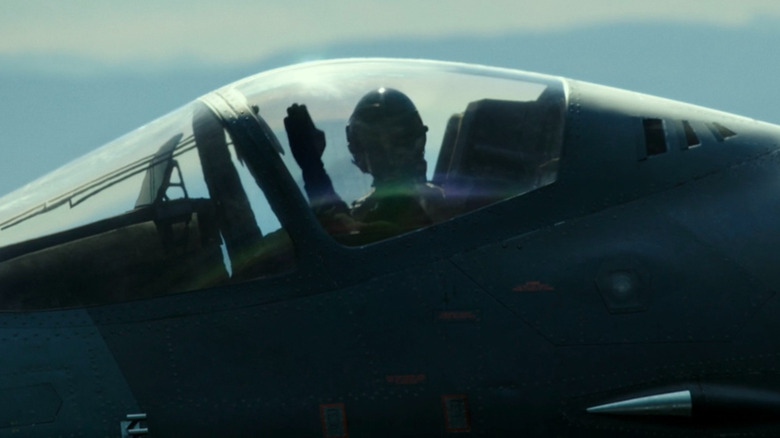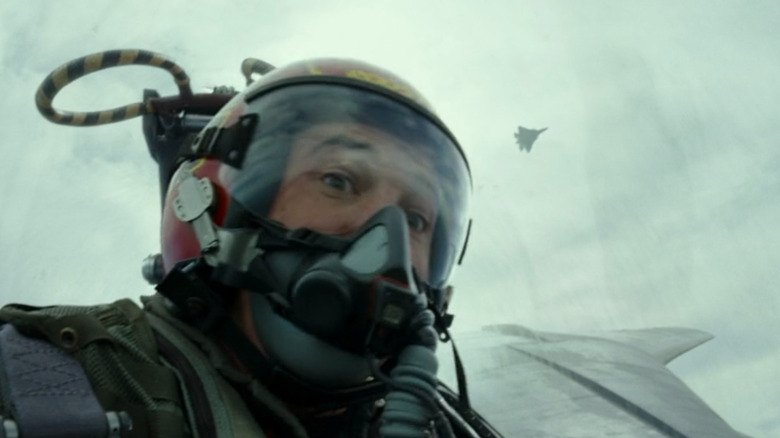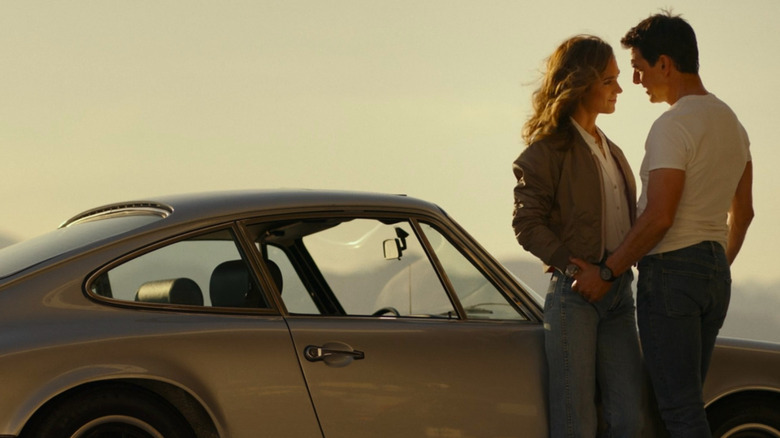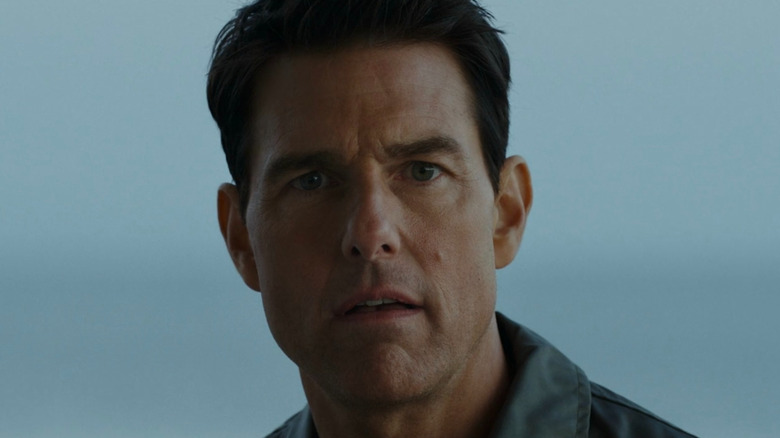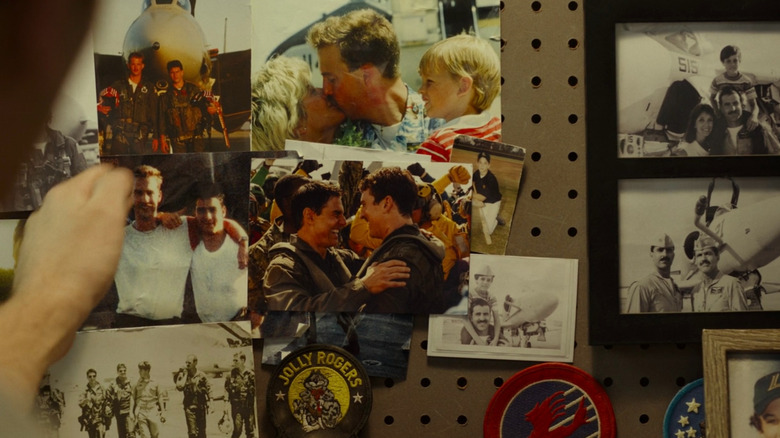Things You Only Notice In Top Gun: Maverick After Watching It More Than Once
When following up a movie as legendary as 1986's "Top Gun" with a sequel that took over 35 years to make it to the screen, the best course of action is to play heavily on the nostalgia and regard for the original film to achieve maximum audience engagement. The way that "Top Gun: Maverick" chose to do this was to bring the past front and center, make redemption and the wisdom that comes with age into key narrative themes, and infuse the film with the ghosts of the past — not just the ghost of Goose, lost in a tragic training accident in the first movie, but the ghosts of all those young, cocky pilots, their mentors, and the lives they led so many years ago.
Some of these references are obvious and overt, such as the opening title card being nearly identical to its predecessor (the only difference being the addition of the word "women") and the inclusion of the pulse-pounding Kenny Loggins anthem, "Danger Zone." Other references are mere echoes of the original "Top Gun" that may take multiple viewings to fully appreciate, and yet those are the ones that flesh out and fully actualize the movie's goals. Let's take a look at them.
Maverick shows his skills
Right from the start, "Top Gun: Maverick" lets its audience know that its titular character, Pete "Maverick" Mitchell — still played by Tom Cruise, albeit a more weathered model — hasn't lost his impeccable flying skills or the roguish character traits which inform his call sign. He starts the film as a test pilot, having been relegated to the desert after his last bout of insubordination. Very similar to his behavior in "Top Gun," Maverick pulls off an amazing bit of flying that is nevertheless against his orders. Due to a quirk of circumstance, he gets sent to Fightertown, USA, aka TOPGUN aerial combat school, this time as an instructor.
Back at TOPGUN, Maverick is now known as an old-timer and the cocky young fighter pilots definitely think they can take him down. But whether he's schooling them in classic dogfighting or acing the test mission track in record time, he can not only hang with the youngsters, he can still best them.
Goose in body and spirit
The emotional core of the original "Top Gun" was the tragic loss of Maverick's best friend and flying partner, Nick "Goose" Bradshaw (Anthony Edwards). His death came after a malfunction during a training exercise that, despite being cleared of all wrongdoing, Maverick blamed himself for. The sequel reveals that Maverick still carries the weight of that incident with him, even all these years later: his workspace is papered with pictures of him and Goose, and he looks wistfully at them as he starts his day. Moreover, he still whispers prayers to Goose, asking for guidance, the same way he did at the climax of the first film. Goose's memory and spirit is always with him.
But Goose is not just a memory in "Top Gun: Maverick," because his son Bradley "Rooster" Bradshaw (Miles Teller) is a veritable carbon copy of Goose's face, mannerisms, and even mustache. His very presence makes Maverick see visions of Goose. Rooster also carries the weight of his father's death with him, and uses his father's spiritual presence to guide his actions, while harboring no small amount of resentment toward Maverick for, in his view, holding back Rooster's own career aspirations.
A 4G inverted dive
In "Top Gun," Maverick and Goose perform some international relations in the form of putting up their middle fingers while taking a 4G inverted dive with a MiG-28. It's this maneuver that garners him extensive notoriety in the Navy and beyond, as well as the notice of Charlotte "Charlie" Blackwood (Kelly McGillis), the flight instructor who becomes his love interest. In "Top Gun: Maverick," the romantic partner is played by Jennifer Connelly and the MiG is an outdated technological fossil, but the inverted dive still exists. Maverick shows up in the dogfighting exercises each time in a way that sneaks up on and surprises his charges. In one sequence he inverts over the other jet and dives with it, spiraling into a corkscrew pattern as they dare each other to chicken out first.
That particular move is a signature of the franchise, but there are several more throughout the film. In the old F-14 at the end of "Top Gun: Maverick," Mitchell buzzes the aircraft carrier tower just like the old days, though he's perhaps learned to no longer ask permission. He's going to do it anyway, after all.
New people in familiar roles
Maverick's signature fly-by is also mirrored in the test plane scene at the start of the film, as he literally blows the roof off a guard gate on the base. But Rear Admiral Cain (Ed Harris), call sign Hammer, stands tall and seemingly unruffled by the massive jet wash that passes over him. Harris wasn't in the original movie, but easily steps in here as another senior naval officer who acts as an antagonist to Maverick, echoing the role originally played by veteran actor James Tolkan in the Indian Ocean scenes of "Top Gun."
Hammer isn't the only character that audiences may not realize is not a returning member from the first film. Jennifer Connelly joins the sequel as Maverick's on-again, off-again love interest Penny Benjamin, but perhaps only the most diehard fans will realize that she is actually the infamous admiral's daughter mentioned in the first film, with whom Maverick had some kind of dalliance that landed him in hot water with her dad.
Knowing that Penny, in "Top Gun: Maverick," is actually a woman that Pete Mitchell has pursued and loved and been involved with many times over the years deepens their relationship and connection, making it feel more earned and authentic as a result. The writers clearly thought a lot about who Maverick was and who he became over the years, as well as who would still be in his life.
Iceman takes over for Viper
In "Top Gun," Commander Mike "Viper" Metcalf (Tom Skerritt) is a senior instructor and also a mentor to Maverick, giving guidance and advice to the young pilot regarding both Goose's death and Maverick's father's passing years earlier. When Maverick returns to his old stomping grounds, it's Tom "Iceman" Kazansky (Val Kilmer) who's in charge of the program now, and while his cancer prevents him from being as hands-on as Viper was, Iceman still shows up to give Maverick advice. In fact, he invites Maverick to his house in much the same way that Viper summoned Mitchell to his doorstep in 1986.
The sequence begins with a shot from the viewpoint of the front door of the house, looking out at the driveway as Maverick approaches. When he enters he's welcomed by his mentor's wife, who greets him warmly and with obvious familiarity. Kids mill about the space, indicating the home is filled with the love of family and friends. Then Maverick has a heart-to-heart talk with the man he came to see, the latter revealing some hard truths while also dispensing some nuggets of real wisdom. In both movies, Maverick leaves the house and the scene feeling bolstered by what he has learned about himself and about life in general. The two scenes are constructed almost identically — it is only the scant altering of circumstances and characters that differentiates the two.
Beach games
Anthony Edwards kept his shirt on for beach volleyball in the original "Top Gun," but Miles Teller sees no need for this precaution when playing dogfight football on the beach as Rooster in "Top Gun: Maverick." In both films, the playful interlude is meant as a tension breaker from the high voltage scenes of fighter pilot training, and in both scenes the audience is treated to an eyeful of man candy.
Whether it's Rick Rossovich as Slider in the original film, striking a classic Mr. Universe flex, or Teller's Rooster in the sequel performing a celebration jig, all attention is firmly on these immaculately oiled-up examples of the masculine figure. Of course, Maverick supposedly has a purpose for arranging the game among his students: building teamwork and camaraderie in the unit. In the first film, it was simply there just to be there, orchestrated high-fives and all — as a visual feast not unlike, as late director Tony Scott put it in an interview on the film's 30th anniversary Blu-ray (via The Wrap), "soft porn." Audiences clearly were not disappointed with the results.
Lack of an identifiable enemy
One thing that made "Top Gun" unique in the heavily Cold War-related military action films of the 1980s was the deliberate lack of an identifiable, specifically-named enemy nation. In "Top Gun: Maverick," director Joseph Kosinski makes that same decision (via The New York Times) to keep the identity of the rogue nation inherently opaque. This is done in order to keep the focus of the film's narrative on the character development of the pilots and their internal struggles, rather than on a political motivation that could be moot in 10 years.
The original film's only clue to their adversary's identity is the aircraft carrier's location in the Indian Ocean, but that provides close proximity to everywhere from Africa to Southeast Asia. All the engagement takes place over the water, too, so details remain slim on where the enemy fighters are launching from.
Likewise, the rogue nation in "Top Gun: Maverick" is cloaked in secrecy, its pilots wearing darkly shaded visors against black flight suits and helmets so as to give no physical features away. Here, however, audiences are given clues surrounding the nation's terrain of snowy mountains and forested land, all of which could still be indicative of a dozen different potential foes. It hasn't stopped people from speculating about nations ranging from Russia to North Korea (per the Los Angeles Times), but the decision not to name an enemy is a smart one that serves both films well.
Lesser technology
First there was the MiG-28, a lighter, more agile, and more maneuverable fighter plane than the F-14s that the Navy flew. In "Top Gun," Maverick's encounter with a MiG before being sent to aerial combat instruction becomes a notable highlight of his naval career, and an item that makes him not just a standout pilot but an asset to Charlie's career as an educator.
In "Top Gun: Maverick," there's the 5th Generation fighter jet that the enemy deploys. It's faster and it can do things the Navy pilots haven't even seen before. They can't outrun it and stand very little chance against one, even in a dogfight. This is the time when Maverick's motto, "It's not the plane, it's the pilot," comes into play, but it's also when the teamwork that Vice Admiral Beau "Cyclone" Simpson (Jon Hamm) calls for Maverick to instill in his pilots is most needed. The stakes have been raised once again, and once again the pilots meet their challenge.
Familiar shots, scenes, and phrases
"Talk to me, Goose" isn't the only phrase to show up in "Top Gun: Maverick" that's repeated from the original film. Another Goose-related statement that makes a reappearance is when Rooster asks Maverick to "do some of that pilot s***" to get them out of a tight spot. But a lot of the shadows and echoes of the original film to be found in the sequel are repeated scenarios and camera shots.
When Phoenix (Monica Barbaro) and Bob (Lewis Pullman) are forced to eject following a bird strike, the next shot shows Rooster sitting with his head down in a dark room. It evokes the scene following Goose's death, when Maverick is filmed in this same way, only this time Phoenix and Bob are fortunately uninjured.
The references aren't just to somber moments, however, as the pilots are faced with the same awkward first day when an unexpected instructor arrives. In "Top Gun," this is Maverick and Goose seeing Charlie after the serenade scene. In "Top Gun: Maverick," this is Hangman (Glen Powell) and Coyote (Greg Tarzan Davis) after throwing Maverick out of Penny's bar the night before.
Penny is another source of deja vu, talking about Maverick having his tail on fire (as opposed to his hair, per Charlie in "Top Gun"). When Penny shows up to reconnect with Maverick at the movie's end, she's standing against her Porsche, recreating another image from "Top Gun" between Charlie and Maverick. These subtle inclusions connect the films subliminally as well as literally, and bond them together tighter in our minds.
Maverick is more vulnerable now
Throughout "Top Gun," Maverick is described as arrogant, reckless, and dangerous. He's cocky to the extreme, whether it's in regard to his flying, his colleagues or his love interests. While he still knows his business and can walk the walk as well as talk the talk in "Top Gun: Maverick," the intervening years have had a mellowing effect on Pete Mitchell, bringing out a lot more of his heart and vulnerability.
Whether it's about his feelings for Penny, or especially his fears, hopes and regrets about Rooster, Maverick wears his heart much closer to his sleeve these days. Maverick fears sending Rooster into danger too early, or even sending him into battle at all, almost as much as he fears losing the young man's respect and affection by holding him back indefinitely. As Penny tells him, he's juggling difficult choices regarding Goose's son, whom he has always wanted to be a surrogate father for since he was orphaned.
The only time Maverick's signature sly smile comes back in earnest, complete with that well-worn cockiness of his, is when he's visiting Iceman. Following their emotional discussion, Iceman asks who the better pilot is, and in the interest of not spoiling the moment, Maverick declines to comment.
Tapping pictures then and now
On his way out the door at the start of "Top Gun: Maverick," Maverick taps his knuckles against the pictures of him and Goose that are all displayed across his workspace. It's a daily acknowledgement of his friend and co-pilot, and the bond that they shared during all their years together. As the film ends, Rooster performs this same action, tapping the pictures of his dad and Maverick to acknowledge the two men who mean the most to him in the world, and finally showing that he is at peace with both the past and the present.
This bracketing of the film with these two identical moves ties the narrative up and makes it abundantly clear that this is a story of the relationships of these two men, who both loved the one they lost. It's also a passing of the torch from the previous generation's hot shot naval aviator to a whole new breed of pilot. Perhaps, as Rear Admiral Cain says at the start of the movie, these types of pilots will soon go extinct in favor of drone fighters that don't need food or sleep and don't disobey orders. Maybe the time left to warriors like Maverick and Rooster is limited. But they still have today.
